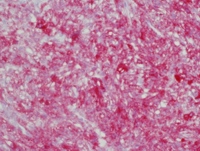Asymptomatic Pancreatic Perivascular Epithelial Cell Tumor (PEComa) in a Male Patient: Report and Literature Review
Abstract
Background Perivascular epithelial cell tumors (PEComas) are a family of rare mesenchymal neoplasms which share cellular, immunohistochemical and ultrastructural characteristics but are found in different visceral and soft tissue sites. PEComas of the pancreas are extremely rare neoplasms. Case report We describe a 49-year-old male who was incidentally diagnosed with a pancreatic mass. Endoscopic ultrasound-guided biopsy suggested a PEComa. An uneventful pylorus-preserving pancreaticoduodenectomy was thus performed. The tumor was a solid well-circumscribed mass in the pancreatic head with dilatation of the main pancreatic duct. Histopathology revealed a well-circumscribed and vascularized neoplasm, measuring 32x27x30 mm, composed of epithelioid smooth muscle cells with clear cytoplasm rich in glycogen. The tumor exhibited immunoreactivity to alpha-smooth muscle actin and to melanoma-associated antigen HMB-45. Conclusions Although rare, pancreatic PEComas should be included in the differential diagnosis of a pancreatic mass. Currently, the paucity of cases published makes it impossible to predict the behavior and prognosis of these tumors or to advocate an optimal therapy.
Image: Positive immunoreactivity to melanoma-associated antigen HMB-45.
Downloads
References
Hornick JL, Fletcher CD. Pecoma: what do we know so far? Histopathology 2006; 48:75-82. [PMID 16359539]
Bonetti F, Pea M, Martignoni G, Doglioni C, Zamboni G, Capelli P, et al. Clear cell ('sugar') tumor of the lung is a lesion strictly related to angiomyolipoma - the concept of a family of lesions characterized by the presence of the perivascular epithelioid cells (PEC). Pathology 1994; 26:230-6. [PMID 7991275]
Martignoni G, Pea M, Reghellin D, Zamboni G, Bonetti F. PEComas: the past, the present and the future. Virchows Arch 2008; 458:119-32. [PMID 18080139]
Zamboni G, Pea M, Martignoni G, Zancanaro C, Faccioli G, Gilioli E, et al. Clear cell "sugar" tumor of the pancreas: A novel member of the family of lesions characterized by the presence of perivascular epithelioid cells. Am J Surg Pathol 1996; 20:722-30. [PMID 8651352]
Ramuz O, Lelong B, Giovannini M, Delpero JR, Rochaix P, Xerri L, et al. Sugar tumor of the pancreas: a rare entity that is diagnosable on preoperative fine-needle biopsies. Virchows Arch 2005; 446:555-9. [PMID 15821930]
Hirabayashi K, Nakamura N, Kajiwara H, Hori S, Kawaguchi Y, Yamashita T, et al. Perivascular epithelioid cell tumor (PEComa) of the pancreas: Immunoelectron microscopy and review of the literature. Pathology International 2009; 59:650-5. [PMID 19712133]
Baez JC, Landry JM, Saltzman JR, Qian X, Zinner MJ, Mortelé KJ. Pancreatic PEComa (sugar tumor): MDCT and EUS features. JOP. J Pancreas (Online) 2009; 10:679-82. [PMID 19890193]
Heywood G, Smyrk TC, Donohue JH. Primary angiomyolipoma of the pancreas. Pancreas 2004; 28:443-5. [PMID 15097863]
Périgny M, Larochelle O, Hammel P, Sauvanet A, Dokmak S, Belghiti J, et al. Pancreatic perivascular epithelioid cell tumor (PEComa). Ann Pathol 2008; 28:138-42 [PMID 18675170]
Folpe AL. Neoplasms with perivascular epithelioid cell differentiation (PEComas). In: Fletcher CDM, Unni KK, Epstein J, Mertens F (eds). Pathology and Genetics of Tumour of Soft Tissue and Bones. Series: World Health Organization Classification of tumours IARC Press: Lyon; 2002; 221-222.
Apitz K. Die Geschwülste und Gewebsmissbildungen der Nierenrinde. II Midteilung Die mesenchymalen Neubildungen. Virchows Arch 1943; 311:306-27.
Bonetti F, Pea M, Martignoni G, Zamboni G. PEC and sugar. Am J Surg Pathol 1992; 16:307-8. [PMID 1599021]
Folpe AL, Mentzel T, Lehr HA, Fisher C, Balzer BL, Weiss SW. Perivascular epithelioid cell neoplasms of soft tissue and gynecologic origin: a clinicopathologic study of 26 cases and review of the literature. Am J Surg Pathol 2005; 29:1558-75. [PMID 16327428]

Copyright (c) 2011 Roni Zemet, Haggi Mazeh, Tzahi Neuman, Herbert R Freund, Ahmed Eid

This work is licensed under a Creative Commons Attribution 4.0 International License.
As a member of Publisher International Linking Association, PILA, iMedPub Group’s JOP follows the Creative Commons Attribution License and Scholars Open Access publishing policies. Journal of the Pancreas is the Council Contributor Member of Council of Science Editors (CSE) and following the CSE slogan Education, Ethics, and Evidence for Editors.